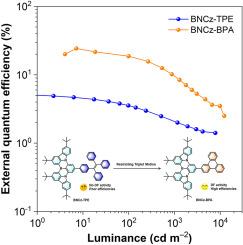Rigid molecular design enables efficient multi-resonance delayed fluorescence for high-performance narrowband OLEDs
IF 4.2
3区 工程技术
Q2 CHEMISTRY, APPLIED
引用次数: 0
Abstract
Creating narrowband organic light-emitting diodes (OLEDs) with high efficiency and color purity is a significant challenge for future high-definition displays. Here, we report a multi-resonance (MR) thermally activated delayed fluorescence emitter, BNCz-BPA, consisting of the classic MR skeleton of BNCz and the rigid 9,10-benzphenanthrene (BPA) unit. By replacing the flexible 1,1,2,2-tetraphenylethylene (TPE) substituent with the rigid BPA unit, triplet excited-state motions are effectively restricted, enhancing the reverse intersystem crossing process (RISC) and producing strong delayed fluorescence. As a result, BNCz-BPA achieves a significantly higher external quantum efficiency (ηext,max) of 24.2 % and a narrower full-width at half-maximum of 40 nm compared to BNCz-TPE (4.9 %, 50 nm), demonstrating the effectiveness of limiting triplet motion. A hyperfluorescence device further enhances electroluminescence performance, delivering an improved ηext,max of 26.2 % and suppressed efficiency roll-off (19.6 % at 1000 cd m−2). This work elucidates the pivotal role of triplet motion in exciton utilization and RISC process, offering a scalable framework for designing high-performance narrowband emitters.

刚性分子设计为高性能窄带oled提供了高效的多共振延迟荧光
创造具有高效率和色彩纯度的窄带有机发光二极管(oled)是未来高清显示的重大挑战。在这里,我们报道了一个多共振(MR)热激活延迟荧光发射器BNCz-BPA,由BNCz的经典MR骨架和刚性9,10-苯并菲(BPA)单元组成。通过用刚性双酚a取代柔性的1,1,2,2-四苯基乙烯(TPE)取代基,有效地限制了三重态激发态运动,增强了反向系统间交叉过程(RISC),并产生了强延迟荧光。结果表明,与BNCz-TPE (4.9%, 50 nm)相比,BNCz-BPA的外量子效率(ηext,max)为24.2%,半峰处的全宽度为40 nm,表明了限制三重态运动的有效性。高荧光器件进一步提高了电致发光性能,提高了η - ext,最大值为26.2%,抑制了效率滚降(在1000 cd m−2下为19.6%)。这项工作阐明了三重态运动在激子利用和RISC过程中的关键作用,为设计高性能窄带发射器提供了一个可扩展的框架。
本文章由计算机程序翻译,如有差异,请以英文原文为准。
求助全文
约1分钟内获得全文
求助全文
来源期刊

Dyes and Pigments
工程技术-材料科学:纺织
CiteScore
8.20
自引率
13.30%
发文量
933
审稿时长
33 days
期刊介绍:
Dyes and Pigments covers the scientific and technical aspects of the chemistry and physics of dyes, pigments and their intermediates. Emphasis is placed on the properties of the colouring matters themselves rather than on their applications or the system in which they may be applied.
Thus the journal accepts research and review papers on the synthesis of dyes, pigments and intermediates, their physical or chemical properties, e.g. spectroscopic, surface, solution or solid state characteristics, the physical aspects of their preparation, e.g. precipitation, nucleation and growth, crystal formation, liquid crystalline characteristics, their photochemical, ecological or biological properties and the relationship between colour and chemical constitution. However, papers are considered which deal with the more fundamental aspects of colourant application and of the interactions of colourants with substrates or media.
The journal will interest a wide variety of workers in a range of disciplines whose work involves dyes, pigments and their intermediates, and provides a platform for investigators with common interests but diverse fields of activity such as cosmetics, reprographics, dye and pigment synthesis, medical research, polymers, etc.
 求助内容:
求助内容: 应助结果提醒方式:
应助结果提醒方式:


